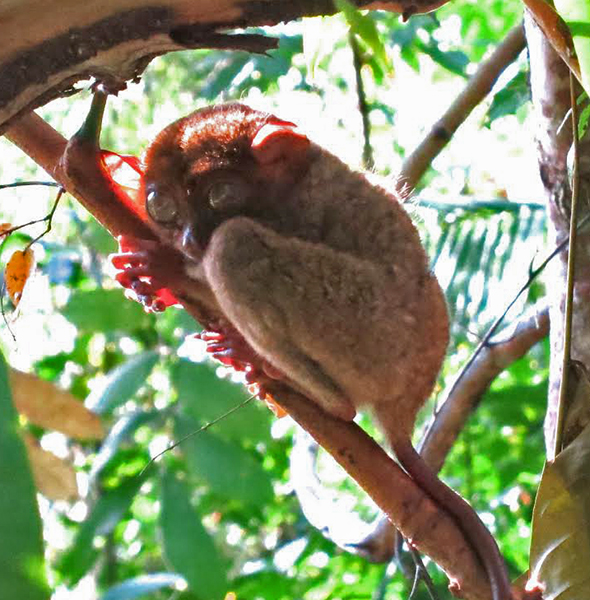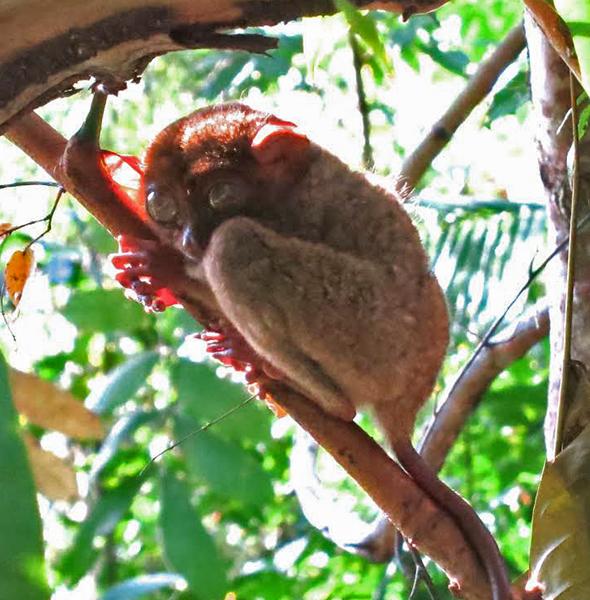KID REPORTERS’ NOTEBOOK
Protecting Tarsiers


A tarsier at the Loboc Tarsier Conservation Area in Bohol.
Tarsiers are among the smallest primates in the world. Their unusually big eyes are the size of their brains, but the animals only grow to be about five or six inches in length. In the Philippines, tarsiers live on an island called Bohol. Unfortunately, Philippine Tarsiers are an endangered species. That means they are close to extinction and may completely die out.
I first saw a tarsier 10 years ago while visiting Bohol. On a tour down the famous Loboc River, my family and I stopped to see the tarsiers. Back then, the tiny primates were on display for tourists. We weren’t allowed to touch the tarsiers, but we could get really close and take photographs with a flash camera. This is damaging to tarsiers' eyes because the animals can only see at night. During our tour, we could even feed the tarsiers crickets on sticks. Such close encounters were extremely harmful to the animals, and many of them died out.
On a recent return trip to Bohol, I visited a sanctuary that has been created to better protect tarsiers. The Loboc Tarsier Conservation Area provides a natural, wooded habitat where tarsiers feed on insects, lizards, and small birds. Tourists must be very quiet because the animals are nocturnal, which means that they sleep during the day.
While at the sanctuary, I spoke with Maridel Legaspi, who helps take care of the tarsiers. She said that the tiny primates are also endangered because people catch them and sell them as pets. When kept in captivity, tarsiers are extremely self-destructive. “If they are caged, tarsiers will smash their heads against the bars,” Legaspi said. “If they are stressed, they will bang their heads on the trees or go on hunger strikes.”
SOLITARY CREATURES
Legaspi’s organization helps protect tarsiers by establishing and providing sanctuaries that protect these adorable creatures from tourists. “Tarsiers are nocturnal, solitary, and territorial creatures,” Legaspi said. “They are most active at night when they jump from tree to tree.”
As territorial animals, tarsiers typically mark out a territory in the wild. If another tarsier is detected within their territory, a fight will ensue, usually ending in death.
The Loboc Tarsier Conservation Area provides each tarsier with its own space, ensuring that tourists don’t get too near. Tarsiers are now protected by law and are carefully watched in sanctuaries like this one. Tourists are led through the area by knowledgeable tour guides.
Katy Smith, a kindergarten teacher from the United Kingdom, was on a trip to see the tarsiers with her fiancé. I was able to ask her what she thought of the tiny animals.
“We read about the tarsiers in a Philippine guidebook,” Smith said, as her fiancé snapped a few photos of the primates from the guardrail—without using a flash, of course. “We thought they sounded cute so we came, and they’re really sweet. They’re smaller than I thought they would be.”
Smith will be using photos of tarsiers in an upcoming lesson with her kindergarten class, when she teaches about measurements.
